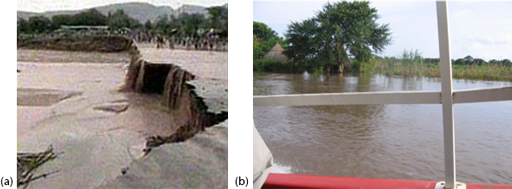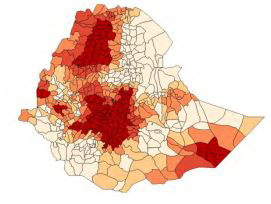10.2.2 River floods and their causes
River floods occur when the water level rises and water spills over the top of the river banks. The overflow runs into nearby low-lying areas, where it collects as flood water (Douben, 2006). River floods in Ethiopia generally occur because of intense heavy rain at high altitudes, which results in water flowing down into lowland rivers, which then burst their banks. Unlike flash floods, river floods tend to build up slowly, but they remain for much longer periods. Figure 10.2 shows river floods in Dire Dawa and Gambela.

Look at the map in Figure 10.3. Which parts of Ethiopia are prone to flooding?
The main flood prone areas in Ethiopia are in the centre of the country in parts of SNNPR and Oromia, in the north in Amhara region and in the south-east in Somali region.

The impacts of river floods depend on many factors, such as the presence of early warning systems (Bonacci and Ljubenkov, 2008). There is no effective early warning system in place in most flood-prone areas of Ethiopia, but rural communities can reduce the impact, for example by moving livestock to higher ground at the start of the flood season. But this precaution is only effective for the normal intensity and frequency of floods – it cannot deal with unusually extreme flooding – and people in urban communities are usually unable to take any action to avoid flood damage.
The severity of flooding is increased by the absence of vegetation, intensive farming methods and deforestation, all of which increase soil erosion. Bare soil is more easily washed away by heavy rain than soil that is held together by the roots of trees and other plants. Soil erosion is the main cause of increased amounts of sediment in many Ethiopian reservoirs. As soil is washed off the land into the reservoir, sediment builds up behind the dam and it can significantly reduce the reservoir capacity, leaving the dam less able to withstand a major flood.
10.2.1 Flash floods and their causes
